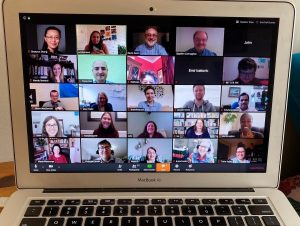Less than three months into the COVID-19 pandemic, Americans are already adjusting to some big changes in their day-to-day lives. Perhaps the biggest? Finding a way to work, play, and gather when the traditional methods are forbidden by social distancing rules.
Happy hours, family gatherings, classes, and meetings are all still happening in quarantined America — it’s just that thanks to a growing number of teleconferencing and virtual meeting applications, they are now taking place in a virtual setting. The popular Zoom teleconferencing software has skyrocketed to prominence in recent weeks, with its daily active user count climbing 340 percent since December 2019 (Bary, 2020). Competitor Microsoft Teams’ daily user count, meanwhile, climbed nearly 40 percent in just one week during March 2020 (Paul, 2020). The University Libraries are in on the trend, too: Since the middle of March, the University Libraries has held two of its monthly All-Staff Meetings via Zoom, providing a way for staff to reconnect and stay productive. We are also using Google Meet and Zoom to bring regular reference and instruction services to our patrons.

Are virtual-only gatherings the future? Right now, there are a number of potential drawbacks, including privacy and security concerns and the risk of lowered productivity. But virtual meetings may also provide a way for organizations — particularly libraries — to continue to better serve their patrons even after the lockdowns are lifted.
“Zoom-Bombing” and Data Protection
Some of the main concerns about the rapid adoption of virtual meetings are privacy and security. Several high-profile anecdotes about “Zoom-bombings” — cases where hackers broke into a virtual meeting to share inappropriate language or images with attendees — have highlighted the need for caution. According to experts, any organization contemplating adopting videoconference applications should have two top priorities:
- End to end encryption. In end-to-end encryption, communications are encrypted on the sender’s device and can only be decrypted by the recipient. This prevents third parties (in this case, the virtual meeting application) from accessing the data while it is sent (“End to end encryption,” n.d.). (Note that Zoom, in particular, has run into questions about its encryption or lack thereof.)
- Data protection. When choosing a virtual meeting or teleconferencing application, organizations should look for transparency about what kind of user data is collected, whether any third parties have access to that data, and whether the application adheres to privacy laws and standards (Paul, 2020).
Choose the Features You Need
Not all virtual meeting applications work for every team, so it is worth researching to find out which features are right for yours. A first consideration might be price; several of the most popular virtual meeting applications offer limited services for free. For example, Zoom’s free option allows unlimited one on one meetings, but caps groups at 40 minutes and 100 participants; Microsoft Teams’ free tier offers even more functionality (Bott, 2020). Others, like Blue Jeans Meetings and GoToMeeting, offer no free services but do have tiered pricing that can accommodate everything from a single person to a large enterprise (Bott, 2020).

Interoperability is also a concern — which software works best with your (or your organization’s) email, calendar, and collaboration platforms? For example, Google Hangouts Meet might be a good choice for organizations that use Google’s other business applications such as Gmail, Google Calendar, and Google Drive (Bott, 2020). The better the match, the more seamless the transition from physical to virtual meetings will be.
Keep the Connection Going
A virtual meeting can never replace in-person camaraderie and exchange of ideas. But there are some best practices for making a virtual meeting close enough to the real thing. Among them: ask all participants to use video — seeing our colleagues up close is heartening in a lonely time. On the other hand, make sure everyone mutes their microphone unless they are speaking, to minimize feedback and distracting background noise. And rather than force meeting-goers to watch long PowerPoint presentations or listen to a single presenter, encourage a dialogue that lets everyone contribute and be heard (Frisch & Greene, 2020).
Pete Ramsey, a Mullen Library liaison librarian and Outreach and Engagement Coordinator, has been offering virtual library instruction since the stay-at-home orders began. He recommends that instructors or meeting facilitators regularly “check for understanding” during sessions. “It’s helped to make sure the students are actually following what I’m trying to demonstrate,” he says. “For one-on-one sessions, I may have them share their screen so I can troubleshoot searching issues.”

The Virtual Library
Libraries are vital partners in their communities, whether those communities are public, academic, or organization-based. Even in a time when physical services are minimal or nonexistent, virtual meeting software can help libraries continue to serve their patronsan, d may even help them find ways to expand their services once physical library visits are possible again.
Here are some ways libraries — including the University Libraries — using virtual meetings for their services.
- Reference: While many patrons are using email to reach out to librarians with reference questions, virtual meetings can add a more personal dimension. Lea Wade, Mullen Library’s STEMM liaison librarian, recently used Zoom to share her screen and demonstrate to a student how to locate subject guides and databases. “I ran through a few searches for her topic in different databases, showing how to use the database’s limiters in advanced search mode. I also showed how to send the articles to a citation manager, then emailed them to her. It took about an hour, and she was pleased with the results,” she said. “I think being able to share my screen was especially helpful because she could see what I was doing and follow along.”
- Instruction: Just as other schools, from K-12 to higher education, have moved classes online, so have libraries. Mullen Library’s liaison librarians have continued to offer library instruction to their departments. In addition, Kevin Gunn, the University Libraries’ Coordinator of Digital Scholarship and a liaison librarian, has taught or co-taught several webinars on such topics as open access, scholarly publishing, and digital scholarship. “Showing students how to do something on a website while you are showing your screen and the students are following along on the same computer can be challenging,” he says. Gunn suggests using short, pre-recorded tutorials for asynchronous learning, and devoting virtual meeting time to discuss specific research issues and questions.
Even though Catholic University plans to reopen in the fall for on-campus instruction and residence life, it remains to be seen how the COVID-19 pandemic may change higher education — and libraries — forever. Virtual tools such as these, however, help ensure that all patrons, no matter where they are, can continue to get the benefit of librarians’ expertise.
— Tricia Bailey
References
Bary, E. (n.d.). Zoom, Microsoft Teams usage are rocketing during coronavirus pandemic, new data show. MarketWatch. Retrieved May 5, 2020, from https://www.marketwatch.com/story/zoom-microsoft-cloud-usage-are-rocketing-during-coronavirus-pandemic-new-data-show-2020-03-30
Bott, E. (n.d.). Best video conferencing software for business: Microsoft Teams plus eight more Zoom alternatives. ZDNet. Retrieved May 21, 2020, from https://www.zdnet.com/article/best-video-conferencing-software-and-services-for-business/
Frisch, B., & Greene, C. (2020, March 5). What It Takes to Run a Great Virtual Meeting. Harvard Business Review. https://hbr.org/2020/03/what-it-takes-to-run-a-great-virtual-meeting
Paul, K. (2020, April 9). Worried about Zoom’s privacy problems? A guide to your video-conferencing options. The Guardian. https://www.theguardian.com/technology/2020/apr/08/zoom-privacy-video-chat-alternatives
What is end-to-end encryption (E2EE)? – Definition from WhatIs.com. (n.d.). Retrieved May 6, 2020, from
https://searchsecurity.techtarget.com/definition/end-to-end-encryption-E2EE
